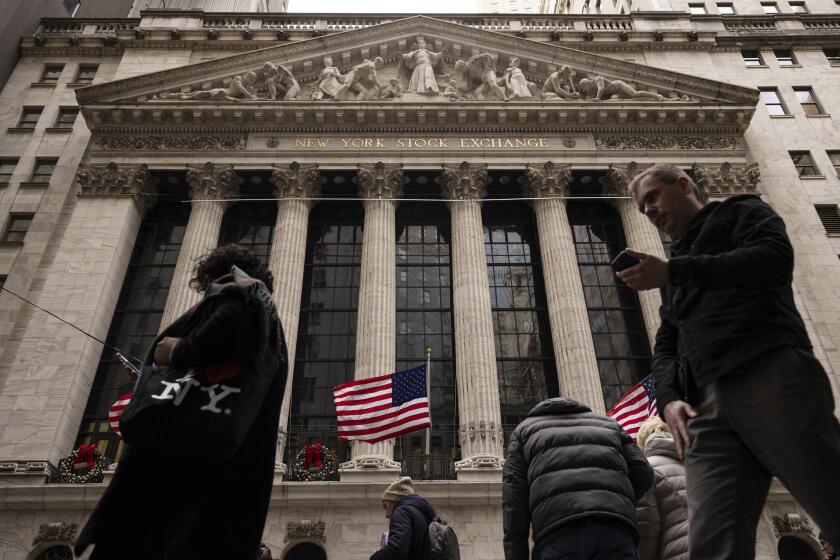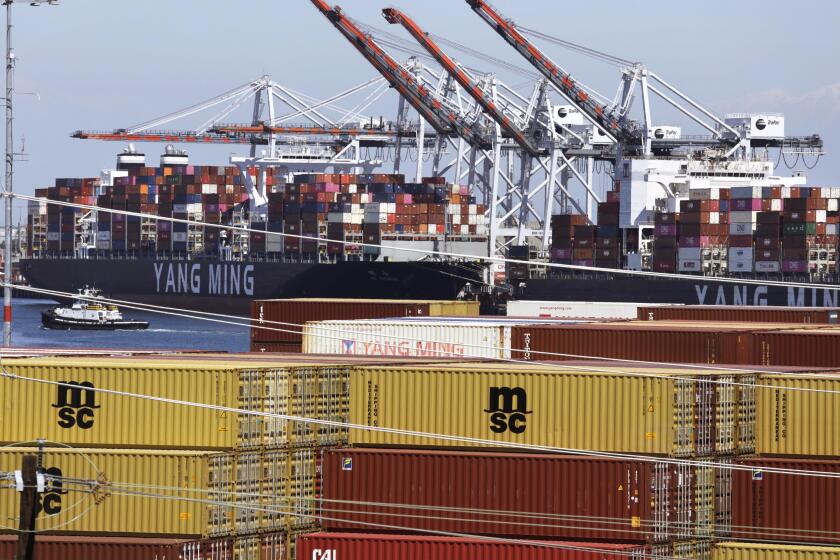Cargo traffic jumped at L.A. and Long Beach ports in January, rebounding from labor troubles

- Share via
The ports of Los Angeles and Long Beach reported sharply higher cargo traffic in January, part of a rebound from 2023 when freight movement fell as labor troubles pushed shippers to competing harbors on the East and Gulf coasts.
The boom in business may also have legs. Port officials have said they have heard from shippers that they are shifting cargo to the massive Southern California cargo container complex — the nation’s largest — to avoid attacks on shipping in the Red Sea and the drought-driven bottleneck at the Panama Canal.
The Los Angeles docks had the second-busiest January on record, handling 855,652 cargo containers, said Gene Seroka, executive director of the Port of Los Angeles. That represents a nearly 18% jump from a year earlier and was second only to the 865,595 containers in January 2022, when U.S. consumers were still on their pandemic-era spending spree.
“The port of Los Angeles is off to a great start,” Seroka said Wednesday in his monthly teleconference on port operations. “Retailers and manufacturers are gearing up for more consumer spending,” and are bringing in goods for store shelves and parts for factories to respond.
“We’re going to see a better year for cargo flow than we saw in 2023. The American consumer continues to buy in the face of a downturn in interest rates and higher inflation,” he said.
Just a quarter of business economists and analysts expect the United States to fall into recession this year.
Long Beach’s port handled 674,015 containers in January, up 17.5% from a year earlier.
“It was also our fifth consecutive month of increase,” said Mario Cordero, the Port of Long Beach’s chief executive. “In terms of business at the Port of Long Beach, all is good.”
The two ports, which handle nearly 40% of U.S. container imports from Asia, are a key economic engine in Southern California, home to a sprawling freight transportation and warehouse network that employs thousands of people.
Business boomed during the pandemic, resulting in a port logjam that sent shippers to competing ports. Then early last year, labor disruptions broke out as West Coast dockworkers became frustrated by slow progress in contract negotiations, and some shippers headed to East and Gulf coast ports. After a tentative contract agreement was reached in June, business began to return, port statistics show.
Now, the ports may see more freight because of problems at two of the world’s most important cargo routes: the Panama Canal and the Suez Canal.
Southern California’s twin ports could see more freight business as shippers seek new routes away from problems at the Suez Canal and the Panama Canal.
The Panama Canal has experienced an unprecedented drought that has lowered water levels and caused a backup of cargo ships. Retailers and manufacturers use the canal as an alternate route to the Eastern U.S. for goods from Asia, rather than taking the shorter sea route to Southern California and the rest of the trip by truck or train.
Because of Houthi rebel attacks on ships in the Red Sea, Egypt’s Suez Canal has lost significant business as cargo heading west from Asia to Europe and the East Coast of the U.S. is being rerouted at great expense around Africa’s Cape of Good Hope.
During his recent trip through Asia, Seroka said, “shippers are beginning to tell me that they are starting to reroute over to the West Coast of the United States basically because of the uncertainty. It’s not a deluge of freight, but we do see a little bit of an uptick because of these changes.”
But increased business at the ports also brings increased pollution, and regional pressure to solve the problem has been increasing.
California Lt. Gov. Eleni Kounalakis, who joined Seroka at the monthly cargo news briefing, pointed to plans for infrastructure improvement, including the Energy Department’s recent decision to award as much as $1.2 billion to a public-private partnership formed to lead California’s bid to create a hydrogen hub. Manufacturers have begun to develop semitrucks powered by hydrogen fuel cells, and shipping lines have announced steps in deploying cargo container ships fueled by hydrogen or methanol.
Kounalakis said green hydrogen “is one of the very interesting areas where the United States and California are investing with the great hope that it will be one of the the important ways that we fuel the transportation industry, particularly in the case of heavy-duty trucks and some of the equipment here at the ports. That’s why the selection of California as a hydrogen hub is very important and very exciting.”
Tyler Reeb, interim executive director for the Center for International Trade and Transportation at Cal State Long Beach, said that there is “great potential in developing a hydrogen hub to serve the Southern California supply chain. And the best place to start this effort is with the San Pedro Bay ports, starting first with heavy trucking, but there are also exciting applications of hydrogen for heavy rail locomotives and in the shipping sector.”
More to Read
Inside the business of entertainment
The Wide Shot brings you news, analysis and insights on everything from streaming wars to production — and what it all means for the future.
You may occasionally receive promotional content from the Los Angeles Times.













